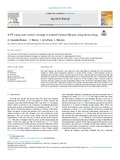A PV ramp-rate control strategy to extend battery lifespan using forecasting
Fecha
2022Autor
Versión
Acceso abierto / Sarbide irekia
Tipo
Artículo / Artikulua
Versión
Versión publicada / Argitaratu den bertsioa
Identificador del proyecto
Impacto
|
|
10.1016/j.apenergy.2022.119546
Resumen
This study analyses and presents a new ramp-rate control algorithm for smoothing PV power fluctuations, designed to address three fundamental objectives: to reduce battery cycling, to meet minimum storage requirements and to be able to operate, without ramp-rate violations, with real publicly-available forecasting. The algorithm was compared to three benchmark methods and, as a performance limit, ...
[++]
This study analyses and presents a new ramp-rate control algorithm for smoothing PV power fluctuations, designed to address three fundamental objectives: to reduce battery cycling, to meet minimum storage requirements and to be able to operate, without ramp-rate violations, with real publicly-available forecasting. The algorithm was compared to three benchmark methods and, as a performance limit, also to a hypothetical perfect prediction. Different performance variables were analyzed for all the strategies within a restricted ramp-rate constraint (2%/min): minimum storage requirement, battery power distributions, throughput energy, state of charge (SOC) distributions, degradation (calendar and cycling), expected battery lifespan and levelized cost of energy (LCOE). The proposal proves to be the most cost-effective smoothing technique and the simulation results show that its performance is comparable to the obtained with the use of an assumed perfect prediction. [--]
Materias
PV fluctuations,
PV smoothing,
Ramp-rate limitation,
Energy storage Systems (ESS),
PV integration,
Levelized Cost of Energy (LCOE)
Editor
Elsevier
Publicado en
Applied Energy, 2022, 323
Departamento
Universidad Pública de Navarra. Departamento de Ingeniería Eléctrica, Electrónica y de Comunicación /
Nafarroako Unibertsitate Publikoa. Ingeniaritza Elektrikoa, Elektronikoa eta Telekomunikazio Ingeniaritza Saila
Versión del editor
Entidades Financiadoras
Support of the Spanish State Research Agency (AEI) under grants PID2019111262RB-I00 and
PID2019-110816RB-C21. Open access funding provided by Universidad Pública de Navarra.







